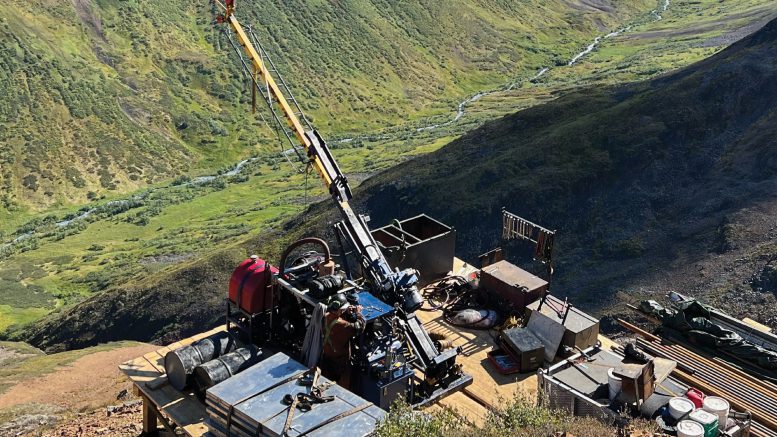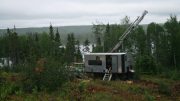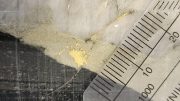Our TNM Drill Down features highlights of the top gold assays from Jan. 19-26. Drill holes are ranked by gold grade x width, as identified by data provider Mining Intelligence.

Rogue in Canada
Snowline Gold’s (TSXV: SGD) Rogue project in the Yukon produced the week’s best assay result. On Jan. 22, the company reported hole V-23-070 cut 382.4 metres at 2.12 grams gold per tonne from 3.7 metres depth for a width x grade value of 910.
The hole included 113.4 metres at 3.5 grams gold from the same depth. This hole was oriented southeast, the first significant exploration in that direction compared with the previous southwest and northeast-directed exploration focus.
Holes V-23-068 and V-23-069, in the northeastern area of the site, have expanded the known high-grade zone, which remains open to the southeast. The newly outlined area will be a focus for further drilling this year at the Valley target.
The company also plans to undertake advanced metallurgical testing.
The Valley target at Snowline’s Rogue project is a new, bulk tonnage, reduced intrusion-related gold system resembling large-scale mines like Kinross Gold‘s (TSX: K; NYSE: KGC) Fort Knox and Victoria Gold’s (TSX: VGCX) Eagle Mine, showing high-grade gold near the surface in wide drill intersections, with potential for additional similar deposits across the project area.
North Laverton in Western Australia
Emerald Resources (ASX: EMR) reported the week’s second-best assay result on Jan. 24 from its North Laverton project in the Dingo Range greenstone belt of Western Australia. Hole DDRE-BDRC017 returned an intersection of 3.3 metres grading 111.79 grams gold per tonne from 214.74 metres depth for a width x grade value of 369.
The North Laverton project, with Emerald’s 78.05% stake managed by Bullseye Mining, comprises 800 sq. km considered to hold high potential for several independent or satellite gold deposits.
Key prospects include Boundary, Neptune, Stirling, Hurleys, and Bungarra, spanning a 6.4-km strike length.
Results have consistently shown mineral continuity both at depth and along the strike. The company aims to update its resource estimates in early 2024, paving the way for reserve statements and potential development decisions later this year.
The current gold eesources of the North Laverton project, as reported by Bullseye Mining, entail 2.7 million tonnes at 2.37 grams gold epr tonne for 212,000 oz. at the Boundary deposit, 545,000 tonnes at 3.26 grams gold per tonne for 57,600 oz. at the Bungarra deposit, and 88,000 tonnes grading 2.25 grams gold per tonne for 6,4000 oz. metal at the Stirling deposit. These resources areestimated under the Joint Ore reerves Committee guidelines of 2012 across three resource categories.
The project currently uses two reverse circulation percussion drill rigs and one diamond rig for resource drilling, exploring extensions along the strike, and probing other regional targets.
Bluebird in Western Australia
The week’s third-best drill result comes from Westgold Resources’ (ASX: WGX; US-OTC: WGXRF) Bluebird underground mine at the Meekatharra operation, Western Australia. The company said on Jan. 25, hole 23BLDD243 returned 23.68 metres grading 12.63 grams gold per tonne from 178 metres depth, for a width x grade value of 299.
Westgold has announced an expansion of Bluebird, doubling its output to 500,000 tonnes per year at 4-5 grams gold per tonne. Highlight results such as 35.31 metres at 5.7 grams gold suggest further potential increases in both grade and scale, and could extend the mine life by over three years.
The company’s strategy focuses on the under-explored 7-km-long Bluebird trend, incorporating the Bluebird and Paddy’s Flat mines as primary ore sources for the 1.6-1.8-million-tonnes-per-year processing plant. The lack of deep drilling offers opportunities to discover new orebodies near the processing hub.
The proposed third decline into the South Junction orebody could increase production to about 750,000 tonnes yearly at a 4-5 grams gold head grade, significantly boosting Bluebird’s output and lifespan.
Part of the company’s Murchison Gold Operations division, the resource update will feed into the existing 87.7 million tonnes grading 2.47 grams gold per tonne for 7 million oz. across all categories.
Westgold is currently operating two surface and three underground drills to conduct infill drilling at the South Junction to expand the Bluebird reserve and to explore potential resource extensions in under-drilled areas along strike and at depth below South Junction and Bluebird.






Be the first to comment on "TNM Drill Down: Snowline Gold’s Rogue reports the week’s top assay"